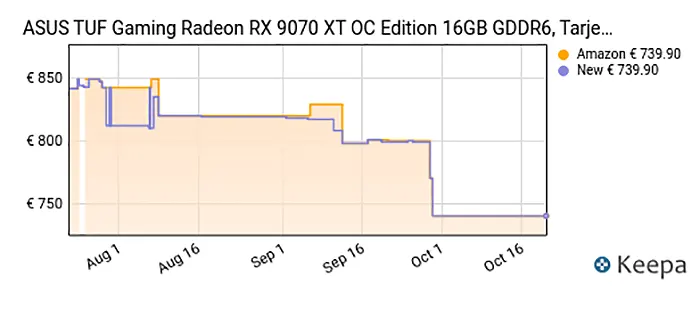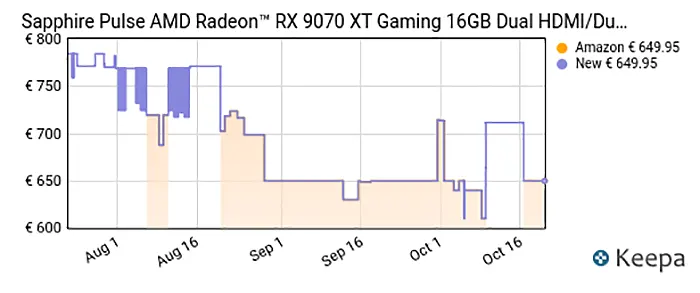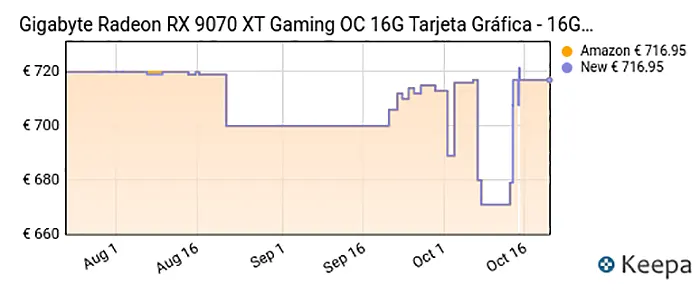- AMD has gradually reduced the price of the Radeon RX 9070 XT.
- Variants like the ASUS TUF, Sapphire Pulse, and Gigabyte OC RX 9070 XT have seen as much as a 31% discount over the MSRP.
- The company has also increased stock to ensure people are able to get their hands on the GPU.
AMD continues to receive positive feedback with RDNA 4, and while Nvidia has significantly grown its market share against its main competitor, the reds appear to be fighting back in the best way possible.
Recently, the company has cut the price for a graphics card like the RX 9070 XT while improving the stock situation to make it more accessible to a wider market. Moreover, there are currently models below the MSRP in the United States.
We took three graphics card models from various brands and examined what has happened since their release using data and dates.
The specific models are the ASUS TUF Gaming Radeon RX 9070 XT OC Edition 16 GB, which has three fans and an oversized PCB with military-grade components, the Sapphire Pulse Radeon RX 9070 XT 16 GB Dual, which is the best-selling model in the brand’s entry-level range, and the GIGABYTE Radeon RX 9070 XT Gaming OC 16 GB, which is similar to the Sapphire.
- AMD Software: Adrenalin Edition application
The ASUS first appeared in March, although it was not widely available until mid-April. Its price during that month exceeded €900, specifically €935. By the end of May, ASUS dropped its price to €790, then surged beyond €800 until mid-September, when it stood exactly on the border between the two figures.
The price reduction for the RX 9070 XT came at the conclusion of that month and the beginning of this one, when ASUS reduced it to the current €739.90. This implies AMD and ASUS have lowered their prices by nearly 21%.
Sapphire reached €820 at the beginning of the year and remained that way until mid-August, when it was out of stock on Amazon for a month and a half. At the end of the summer, it arrived with many more units, suggesting that AMD was making a move and that more sales would take advantage of the lower prices.
- Military-grade components deliver rock-solid power and longer lifespan for ultimate durability
That is why, in early September, Sapphire hit the table and fell to €649.90, a price it has held to this day. And it sold out last week, which was understandable given the price and model.
As for Gigabyte, the same thing is repeated with ASUS and Sapphire, with much higher prices at launch, a sharp drop in mid-April to €857 from €1,052, and by mid-June it was already at €752. The price drop comes out to about 31% if we take the total average since it went on sale.
Starting in the summer, with a little reduction at the end of August and another last week to an unbelievable €670, the price has settled at €716.
In the case of Sapphire, the results are completely identical to those of ASUS, as the price has dropped by over 21%, with a difference of only 0.1% between the two, a tiny margin between the two brands.
Thank you! Please share your positive feedback. 🔋
How could we improve this post? Please Help us. 😔
[Editor-in-Chief]
Sajjad Hussain is the Founder and Editor-in-Chief of Tech4Gamers.com. Apart from the Tech and Gaming scene, Sajjad is a Seasonal banker who has delivered multi-million dollar projects as an IT Project Manager and works as a freelancer to provide professional services to corporate giants and emerging startups in the IT space.
Majored in Computer Science
13+ years of Experience as a PC Hardware Reviewer.
8+ years of Experience as an IT Project Manager in the Corporate Sector.
Certified in Google IT Support Specialization.
Admin of PPG, the largest local Community of gamers with 130k+ members.
Sajjad is a passionate and knowledgeable individual with many skills and experience in the tech industry and the gaming community. He is committed to providing honest, in-depth product reviews and analysis and building and maintaining a strong gaming community.


 Threads
Threads






